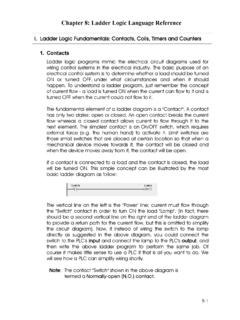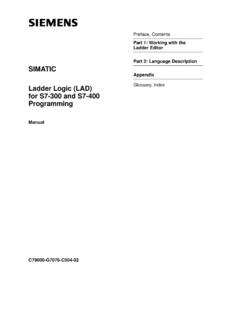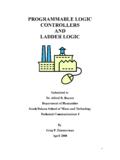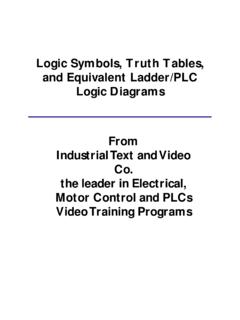Transcription of Objectives: Advanced ladder logic functions allow ...
1 Plc memory - PLC INTRODUCTIONA dvanced ladder logic functions allow controllers to perform calculations, make decisions and do other complex tasks. Timers and counters are examples of ladder logic functions . They are more complex than basic input contacts and output coils and they rely upon data stored in the memory of the PLC. The memory of the PLC is organized to hold different types of programs and MEMORY ADDRESSESThe memory in a PLC is organized by data type as shown in Figure There are two fundamental types of memory used in Allen-Bradley PLCs - Program and Data mem-ory. Memory is organized into blocks of up to 1000 elements in an array called a file. The Program file holds programs, such as ladder logic . There are eight Data files defined by default, but additional data files can be added if they are :Obj ect ives: To know the basic memory types available To be able to use addresses for locations in memory PLC-5 memory types; program and data Data types; output, input, status, bit, timer, counter, integer, floating point, etc.
2 Memory addresses; words, bits, data files, expressions, literal values and memory - C Me PROGRAM FILESIn a PLC-5 the first three program files, from 0 to 2, are defined by default. File 0 contains system information and should not be changed, and file 1 is reserved for SFCs. File 2 is available for user programs and the PLC will run the program in file 2 by default. Other program files can be added from file 3 to 999. Typical reasons for creating other 23999 OutputsO0 InputsI1 StatusS2 BitsB3 TimersT4 CountersC5 ControlR6 IntegerN7 Program FilesData FilesThese are a collection of up to 1000 slots to store up to 1000 pro-grams. The main program will be stored in program file 2. SFC programs must be in file 1, and file 0 is used for program and password information.
3 All other program files from 3 to 999 can be used for is where t he vari able data is stored that the PLC programs operate on. This is quite compli-cated, so a detailed explanation memory - are for a user creates a ladder logic program with programming software, it is con-verted to a mnemonic-like form, and then transferred to the PLC, where it is stored in a program file. The contents of the program memory cannot be changed while the PLC is running. If, while a program was running, it was overwritten with a new program, serious problems could DATA FILESData files are used for storing different information types, as shown in Figure These locations are numbered from 0 to 999. The letter in front of the number indicates the data type.
4 For example, F8: is read as floating point numbers in data file 8. Numbers are not given for O: and I:, but they are implied to be O0: and I1:. The number that follows the : is the location number. Each file may contain from 0 to 999 locations that may store values. For the input I: and output O: files the locations are converted to physical locations on the PLC using rack and slot numbers. The addresses that can be used will depend upon the hardware configuration. The status S2: file is more complex and is discussed later. The other memory locations are simply slots to store data in. For example, F8:35 would indi-cate the 36th value in the 8th data file which is floating point numbers. Figure ta Fil es for an Alle n Bradle y PL C-5O:000I:nnnS2:nnnB3:nnnT4:nnnC5:nnnR6: nnnN7:nnnoutputsinputsprocessor statusbits in wordstim er scounterscontrol wordsinteger numbersRackI/O slot number in rackInterface toFixed types ofoutside worldData filesF8:nnnfloating point numbersOther files 9-999 can be created and user defined data files can have differentdata memory - y the fi rst three data fi les are fixed O:, I: and S2:, all of the other data files can be moved.
5 It is also reasonable to have multiple data files with the same data type. For example, there could be two files for integer numbers N7: and N10:. The length of the data files can be from 0 up to 999 as shown in Figure But, these files are often made smaller to save tions in a Da ta Fil eFigure shows the default data files for a PLC-5. There are many additional data types, a full list is shown in Figure Some of the data types are complex and con-tain multiple data values, including BT, C, MG, PD, R, SC, and T. Re cal l tha t ti mers require integers for the accumulator and preset, and TT, DN and EN bits are required. Other data types are based on single bits, 8 bit bytes and 16 bit words. T4:0T4:1T4:999plc memory - Data TypesWhen using data files and functions we need to ask for information with an address.
6 The simplest data addresses are data bits (we have used these for basic inputs and outputs already). An example of Address bits is shown in Figure Memory bits are normally indicated with a forward slash followed by a bit number /n. The first example is from an input card I:000, the third input is indicated with the bit address /02. The second example is for a counter C5: done bit /DN. This could also be replaced with C5:4/15 to ge t equivalent results. The DN notation, and others like it are used to simplify the task of pro-gramming. The example B3/4 wi ll get t he fourth bit in bit m emory B3. For bit memory the slash is not needed, because the data type is already bits. TypeA - A S CIIB - bitBT - block transferC - counterD - BCDF - floating pointMG - me ss ageN - integer (signed, unsigned, 2s compliment, BCD)PD - PID controllerR - controlSC - SFC statusST - ASCII stringT - ti merLength(words)1/21/1663125618233423 NOTE: Memory is a general term that refers to both files and locations.
7 The term fi le is specific to PLC manufacturers and is not widely recognized memory - Level AddressingEntire words can be addressed as shown in Figure These values will nor-mally be assumed to be 2s compliment, but some functions may assume otherwise. The first example shows a simple integer memory value. The next example gets up to inputs (from card 0 in rack zero) as a single word. The last two examples are more complex and they access the accumulator and preset values for a timer. Here a . is used as the / was used for bit memory to indicate it is an integer. The first two examples don t need the . because they are both integer value types. Other types of word addressing are possible, including floating point Word AddressingData values do not always need to be stored in memory, they can be define liter-ally.
8 Figure shows an example of two different data values. The first is an integer, the second is a real number. Hexadecimal numbers can be indicated by following the number wi th H, a leading zero is also needed when the first digit is A, B, C, D, E or F. A binary number is indicated by adding a B to the end of the :000/02 - the third input bit from input card I:000C5:4/DN - the DN bit of a counterbit - individual bits in accessed - this is like addressing a single output as a data - the fourth bit in bit memoryNOTE: Some bit addresses, especially inputs and outputs are addressed using octal. This often leads to careless errors and mistakes. For example if you want the 11th output bit, or bit 10, you would need to use 12 in octal to address it t h1212th1313th1414th1515th1616th17N7: 8 - the 9t h value from int eger m emoryI:000 - an integer with all input values from an input cardinteger word - 16 bits can be manipulated as an - the accumulator value for a timerT4 - the preset value for a timer plc memory - Data ValuesSometimes we will want to refer to an array of values, as shown in Figure This data type is indicated by beginning the number with a pound or hash sign #.
9 The first example describes an array of floating point numbers staring in file 8 at location 5. The second example is for an array of integers in file 7 starting at location 0. The length of the a rray is det ermi ned el se whe AddressingIndirect addressing is a method for allowing a variable in a data address, as shown in Figure The indirect (variable) part of the address is shown between brackets [ and ] . If a PLC is looking at an address and it finds an indirect address it will look in the specified memory location, and put that number in place of the indirect address. Consider the fi rst exam ple be low I:000/[N7:2], i f the va lue i n the i ntege r mem ory locat ion N7:2 is 45, then the address becomes I:000/45.
10 The other examples are very similar. This type of technique is very useful when making programs that can be adapted for different recipes - by changing a data value in one memory location the program can follow a new set of - an - a floating point numberliteral data value - a data value can be provided without storing it in - a hexadecimal value 8F01101101B - a binary number 01101101#F8:5 - indicates a group of values starting at F8:5#N7:0 - indicates a group of values starting at N7:0file - the first location of an array of data memory - AddressingExpressions allow addresses and functions to be typed in and interpreted when the program is run. The example in Figure will get a floating point number from file 8, location 3, perform a sine transformation, and then add The text string is not inter-preted until the PLC is running, and if there is an error, it may not occur until the program is running - so use this function cautiously.





